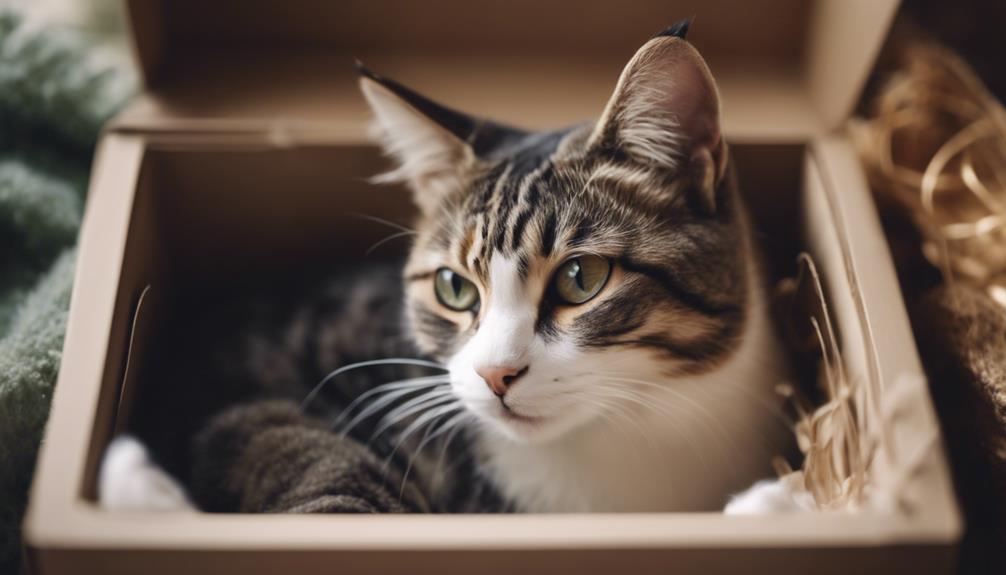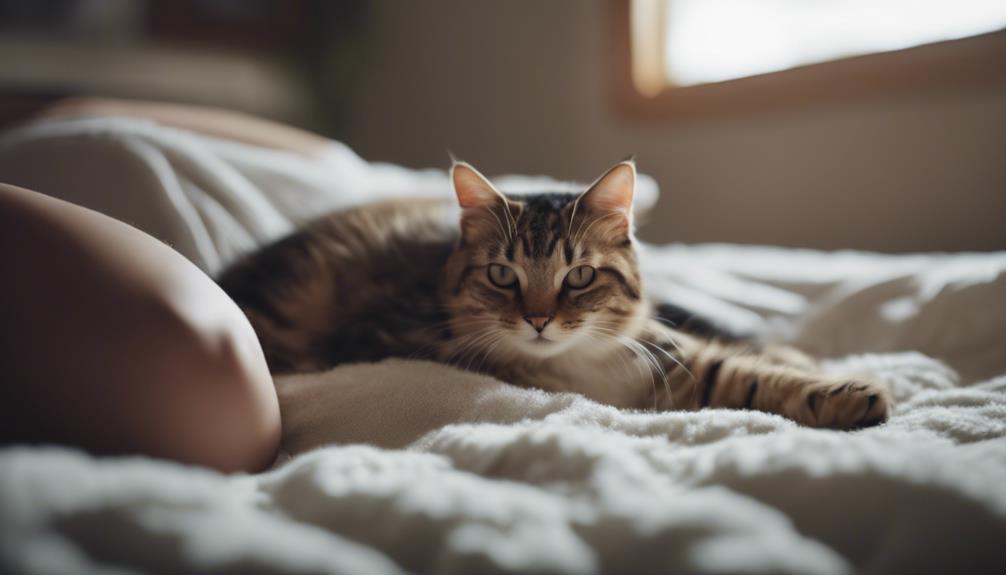Understanding the subtle cues that indicate a feline's readiness to give birth is essential for providing optimal care and support during this crucial time. From behavioral changes to physical signs, recognizing these indicators can help ensure a smooth delivery process.
By being attuned to your cat's needs and having the necessary preparations in place, you can offer the vital support needed for a successful birth. Stay tuned to discover the key signs that your cat is nearing labor and how you can assist your little mama on the big day.
Key Takeaways
- Monitor signs like decreased activity and mammary gland changes.
- Create a warm, quiet nesting space with comfort and closeness.
- Track mammary gland development stages for nursing readiness.
- Be prepared for colostrum leakage as a sign of imminent labor.
Signs of Impending Labor
When a cat is nearing labor, there are distinct signs that indicate she is getting ready to give birth. These signs include a decrease in activity levels, as the cat prepares for the upcoming delivery.
Additionally, you may notice an increase in nesting behavior, where the cat starts to create a comfortable space for giving birth. Keep an eye on the cat's mammary glands, as they will increase in size, and the nipples may start to leak colostrum.
The nipples might also darken, with fur thinning around them in preparation for nursing the kittens. Another sign to watch for is a slight drop in the cat's body temperature just before labor begins.
Nesting Behavior Changes
As a cat nears labor, its instinctual behavior shifts towards creating a secure and comfortable nesting space, a process known as nesting behavior changes. This is a crucial sign that your furry friend is preparing for the arrival of her kittens.
During this time, you may notice the following emotional changes in your cat:
- Increased need for closeness and comfort
- Heightened sense of protectiveness over her nesting area
- More frequent purring and seeking of affection
These behaviors are all indicators of your cat's natural maternal instincts kicking in as she readies herself for the upcoming birth. Providing a warm and quiet space for her to nest will help her feel safe and supported during this significant time.
Mammary Gland Development

The development of a cat's mammary glands is a crucial physiological process that signifies readiness for nursing and caring for her newborn kittens. As a cat's body prepares for birth, her mammary glands undergo changes to support lactation. Here is a table summarizing the stages of mammary gland development:
| Stage | Description | Signs |
|---|---|---|
| Early Development | Mammary glands start to enlarge | Swelling and pink color |
| Mid-Development | Glands continue to grow | Nipples protrude slightly |
| Late Development | Glands reach full size | Nipples prominent and warm |
Understanding these stages can help you anticipate your cat's readiness to nurse her kittens effectively.
Colostrum Leakage
Colostrum leakage from a cat's nipples is a significant indicator of imminent labor and the impending arrival of her kittens. This natural process prepares the mother cat for nursing her newborns, providing vital antibodies and nutrients.
Seeing this precious fluid can evoke a mix of emotions in cat owners, signaling the beautiful journey of new life about to begin. It's a heartwarming reminder of the miracle unfolding within your furry companion.
As you witness this intimate moment, remember to stay calm, supportive, and ready to assist your little mama when the time comes.
- Anticipation of new life
- Warmth and comfort in readiness
- Connection to the miracle of birth
Nipple Changes
Notable alterations in the appearance and texture of a cat's nipples signal impending changes as she nears the delivery of her kittens. The nipples may darken, and the fur surrounding them may thin out. These changes are essential indicators that birth is approaching. To provide a clearer understanding, let's look at the following table detailing the nipple changes:
| Nipple Changes | Description | Significance |
|---|---|---|
| Darkening | Nipples become darker in color | Indicates increased blood flow and readiness for nursing |
| Swelling | Nipples may appear larger | Prepares for milk production and nursing |
| Texture Change | Nipple texture may feel different | Readies for the kittens' suckling behavior |
Temperature Drop
As a cat prepares for labor, a notable physiological indication of impending birth is a slight drop in body temperature. This drop typically occurs within 24 hours before labor commences. It is a natural and essential part of the birthing process, signaling that the little ones will soon arrive.
During this time, it's crucial to provide your cat with a warm and comfortable environment, offering support and reassurance as she prepares to bring new life into the world.
Emotion-evoking bullet list:
- Feel the anticipation as her body temperature subtly decreases, heralding the imminent arrival of her precious kittens.
- Experience the excitement of knowing that soon you will welcome a new litter of adorable furry friends into your home.
- Share in the intimacy of this moment as you witness the miracle of birth firsthand.
Birth Preparation Essentials

What essential items and preparations are crucial for ensuring a smooth and safe birth for your cat and her kittens?
To prepare for the upcoming birth, gather clean towels and blankets to create a cozy nest for the mother and her litter. Additionally, have emergency care items on hand, such as a bulb syringe and dental floss, along with important contact numbers for your vet and the nearest emergency clinic.
Stock up on milk replacer and nursing supplies to support the kittens' early days. Provide heat support with heating discs or warm water bottles and have a clean cat carrier ready for any emergencies.
These essentials will help ensure a comfortable and secure environment for the mother and her newborns.
Emergency Care Kit Items
Essential items for an emergency care kit for a cat giving birth include a bulb syringe, dental floss, and contact numbers for the vet and emergency clinic. In times of need, these items can provide crucial support for both the mother cat and her kittens.
- Bulb Syringe: Helps clear the airways of newborn kittens
- Dental Floss: Useful for tying off the umbilical cords
- Contact Numbers: Vital for quick access to professional assistance
Having these items readily available can offer peace of mind and ensure that you are prepared to handle any unexpected situations with care and efficiency. Remember, being equipped with the right tools can make a significant difference in the well-being of your little mama and her newborns.
Supporting the Mother Cat

Support for the mother cat during the birthing process is essential to ensure the well-being of both the mother and her litter. It is crucial to monitor her closely, ensuring she is comfortable and has a quiet, warm space for delivery. Providing emotional support by staying nearby can help reassure her during this vulnerable time.
Keep the area calm and free from disruptions to minimize stress. Gentle encouragement and physical assistance, if needed, can aid the mother cat in delivering her kittens safely. Remember to have the vet's contact information on hand in case of emergencies.
Feeding Newborn Kittens
Feeding newborn kittens is a critical aspect of their care and development, requiring proper nutrition for their healthy growth. When it comes to nourishing these tiny felines, here are a few tips to help ensure they thrive:
- Gently cradle the kitten while feeding to create a bonding experience.
- Use a warm, damp cloth to mimic the mother's grooming and comfort.
- Make soft, soothing sounds to create a calm and reassuring environment for the kittens.
Additional Cat and Kitten Care Info

When caring for cats and kittens, it is important to understand various aspects of their health and well-being beyond just feeding and nursing. Ensuring the mother cat is producing enough milk and being ready to assist in nursing if needed are crucial steps.
Keeping the vet's phone number handy and having emergency care items like a bulb syringe and dental floss ready can make a significant difference in emergencies. Proper nutrition plays a key role in kitten growth, so having milk replacer, formula, or appropriate food options is essential. Consulting the vet for feeding guidance and being prepared to provide necessary nutrition throughout the first year is vital for their healthy development.
Additionally, learning about spaying, neutering, sick care for newborn kittens, anesthesia, and the differences between feral and stray cats can help you provide comprehensive care for your feline companions.
Frequently Asked Questions
Can a Cat Give Birth Without Any Noticeable Signs of Impending Labor?
Yes, a cat can give birth without noticeable signs of impending labor. Cats may hide signs to protect themselves and their litter. It's essential to monitor closely, provide a safe, quiet space, and be prepared for unexpected deliveries.
How Often Should a Mother Cat Be Checked on During the Birthing Process?
During the birthing process, a mother cat should be checked every 1-2 hours to monitor progress. Regular checks ensure timely assistance if needed. Observation for signs of distress, difficulty in labor, or prolonged intervals between kittens is crucial for maternal and litter safety.
Is It Normal for a Mother Cat to Reject Her Kittens After Giving Birth?
It is not unusual for a mother cat to reject her kittens after birth due to stress, illness, or feeling overwhelmed. Providing a calm environment, monitoring her behavior, and seeking veterinary advice can help address this issue effectively.
What Are Some Common Complications That May Arise During Cat Labor and Delivery?
Common complications during cat labor and delivery include dystocia (difficulty giving birth), retained placenta, uterine inertia, and maternal neglect. Prompt veterinary intervention is crucial to address these issues and ensure the well-being of the mother and kittens.
How Soon After Birth Should Kittens Be Introduced to Solid Food?
Kittens should be introduced to solid food around four to six weeks of age. Begin with moistened kitten food, gradually transitioning to dry kibble. Monitor their progress and consult your vet for guidance on nutrition and weaning.
Conclusion
In conclusion, it is essential to closely monitor a pregnant cat for signs of impending labor, such as nesting behavior changes and mammary gland development.
Having an emergency care kit ready and providing proper support to the mother cat during and after birth is crucial for ensuring the health and well-being of both the mother and her newborn kittens.
By being prepared and informed, cat owners can help facilitate a smooth and safe birthing process for their feline family.




